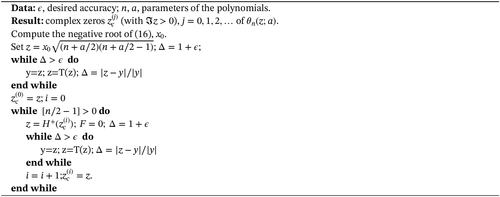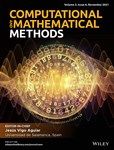Computation of the reverse generalized Bessel polynomials and their zeros
Funding information: Ministerio de Ciencia e Innovación, PGC2018-098279-B-I00 (MCIU/AEI/FEDER, UE)
Abstract
It is well known that one of the most relevant applications of the reverse Bessel polynomials is filter design. In particular, the poles of the transfer function of a Bessel filter are basically the zeros of . In this article we discuss an algorithm to compute the zeros of reverse generalized Bessel polynomials . A key ingredient in the algorithm will be a method to compute the polynomials. For this purpose, we analyze the use of recurrence relations and asymptotic expansions in terms of elementary functions to obtain accurate approximations to the polynomials. The performance of all the numerical approximations will be illustrated with examples.
1 INTRODUCTION
It is well known that generalized and reverse generalized Bessel polynomials have applications in different areas of science and technology, including applied mathematics, mathematical physics, and electrical engineering; see, for example, References 1, 2. It is interesting to mention that the reverse Bessel polynomials (a particular case of the reverse generalized polynomials) are important in filter design.3 In particular, the poles of the transfer function of a Bessel filter are basically the zeros of reverse Bessel polynomials.
Some properties satisfied by these polynomials can be found, for example, in Reference 4. For computing the polynomials, we consider the use of asymptotic expansions in terms of elementary functions given in Reference 5 and a three-term recurrence relation satisfied by the polynomials. The expansions were obtained by using the well-known Liouville-Green theory for ordinary differential equations in the complex plane.
On the other hand, several papers can be found in the literature on the approximation and study of the distribution of the zeros of generalized Bessel and reverse generalized Bessel polynomials; see, for example, References 6, 7. In this article we discuss the numerical performance of an algorithm to compute the zeros of reverse generalized Bessel polynomials . For this, we use the method given in Reference 8, which is based on a qualitative analysis of the approximate Liouville-Green Stokes lines and anti-Stokes lines of the differential equation satisfied by the polynomials, combined with the application of a high-order fixed-point method and carefully selected step functions. As we will see, a method to compute the polynomials will be needed for evaluating the zeros. Therefore, the numerical evaluation of the polynomials will be an essential part of an implementation in finite precision of our algorithm to compute the complex zeros of .
2 COMPUTATION OF THE REVERSE GENERALIZED BESSEL POLYNOMIALS FOR COMPLEX ARGUMENTS
2.1 Asymptotic expansions
In Reference 5, asymptotic expansions for the generalized reverse Bessel polynomials were obtained. Asymptotic expansions were given in terms of Airy functions and in terms of elementary (exponential) functions. In this section, we discuss the computational performance of the expansions in terms of elementary functions, which were obtained by applying the Liouville-Green theory for ordinary differential equations in the complex plane, to approximate .
A first test of the expansion (3) is given in Table 1, where the values of and have been computed with Maple using the relation given in Equation (7) and a large number of digits. For computing the expansion, three coefficients () have been used. As can be seen, an accuracy better than single precision is obtained in most cases. Of course, higher accuracy can be obtained using more coefficients in the expansion; for example, using four coefficients () for , and the errors obtained were and ; therefore, we obtain an approximation with an accuracy 10 times better than before (see Table 1).
| a | z | ||
|---|---|---|---|
| 1.7 | |||
| 1.7 | |||
| 1.7 | |||
| 1.7 | |||
| 20.1 | |||
| 20.1 | |||
| 20.1 | |||
| 20.1 | |||
| 50.7 | |||
| 50.7 | |||
| 50.7 | |||
| 50.7 |
in (12) is given by .
A test for the expansion (11) using the coefficients in (12) is given in Table 2. An accuracy close to single precision is obtained in all cases.
| a | z | ||
|---|---|---|---|
| 1.7 | |||
| 1.7 | |||
| 1.7 | |||
| 20.1 | |||
| 20.1 | |||
| 20.1 | |||
| 1.7 | |||
| 10.1 | |||
| 20.3 |
Tests for are shown in Figures 1 and 2, where the relative errors obtained in the comparisons of the expansions (3) and (11), respectively, to the expression given in (8) are plotted for different values of n. The calculations have been made using Matlab.
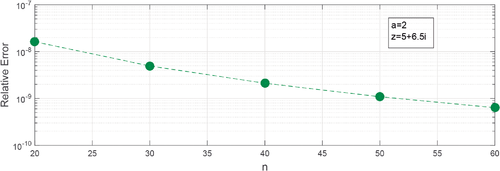
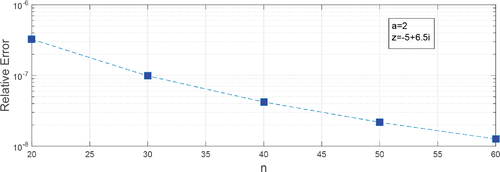
2.2 Recurrence relations
However, a key point that has to be studied before using a recurrence relation, is its conditioning for computing a given function satisfying the recurrence.9 In particular, if a recurrence admits a minimal (or recessive) solution, the forward computation of the recurrence relation is ill conditioned, because a small perturbation of the initial values will introduce a component of a dominant solution. Therefore, the recurrence has to be computed in the backward direction (starting with large n). On the contrary, for a dominant solution, the forward numerical computation is well conditioned.
To analyze the conditioning of (13), we have to use Perron's theorem10 and the asymptotic behavior of the polynomials. Given that the expansions (3) and (11) for the reverse generalized Bessel polynomials are for large values of n, we conclude (using Perron's theorem) that the polynomials are, asymptotically, a dominant solution in the whole complex plane of the three-term recurrence relation (13). Then, the forward computation of the recursion is expected to be well conditioned, at least for large enough n.
Examples of the good computational behavior of (13) evaluated forward, are given in Tables 3 and 4 for two values of z in the first quadrant of the complex plane and few values of a. The recurrence relation (13) has been applied using as starting values and . The calculations have been made in Maple using a large number of digits to compute the two initial values. When applying the recurrence relation, the number of digits has been set to 16 in order to quantify the possible loss of significant digits when using the recursion in a double precision algorithm. As can be seen, only few digits are lost for large values of n and this is due, most probably, to the fact that is extremely large for these n values. Similar results are shown in Table 5 for the evaluation of with z a value in the second quadrant of the complex plane () using (13) in the forward direction.
| n | Rel error | Rel error | Rel error |
|---|---|---|---|
| 10 | |||
| 100 | |||
| 1000 | |||
| 10,000 |
| n | Rel error | Rel error | Rel error |
|---|---|---|---|
| 10 | |||
| 100 | |||
| 1000 | |||
| 10,000 |
| n | Rel error | Rel error | Rel error |
|---|---|---|---|
| 10 | |||
| 100 | |||
| 1000 | |||
| 10,000 |
However, it is important to note that in the z-region where the zeros of lie (second and third quadrants of the complex plane), the good conditioning of (13) in the forward direction can only be seen, depending on the value of z, for large values of n. This behavior is due to the fact that has a component of minimal solution in the region where the zeros lie, particularly near the real negative axis. This minimal solution component can be orders of magnitude larger than the dominant component for n not very large. Ultimately, the dominant component becomes larger for large enough n. For example, Table 6 shows the results obtained in the evaluation of after using of the recurrence relation (13) for two different choices of initial values: a) , (results given in column 2); b) , (results given in column 4). As can be seen in column 2, starting from and for , there is a significant loss of accuracy in the calculations after a moderate number of steps of the recurrence have been used. However, when starting from and for , the good conditioning of the recurrence relation in the forward direction is revealed. A similar example is shown in Table 7 for the evaluation of again using of the recurrence relation (13). The initial values are: a) , (results given in column 2); b) , (results given in column 4). As can be seen in column 2 of Table 7, the loss of accuracy is even greater than before. Accurate values for where the forward recurrence fails, can be obtained using the recurrence backwards. Examples of this are shown in Table 8 for the two z values considered in Tables 6 and 8.
| Rel error | Rel error | ||
|---|---|---|---|
| 10 | |||
| 20 | |||
| 30 | |||
| 40 | |||
| 50 | 0.005 | 10,000 |
- Note: The starting values used are a) , (columns 1, 2); b) , (columns 3, 4).
| Rel error | Rel error | ||
|---|---|---|---|
| 10 | 10 | ||
| 20 | 100 | ||
| 30 | 500 | ||
| 40 | 1000 | ||
| 50 | 0.27 | 10,000 |
- Note: The starting values used are: a) , (columns 1, 2); b) , (columns 3, 4).
| Rel error | Rel error | ||
|---|---|---|---|
- Note: The starting values used are: a) , to obtain the results in column 2; b) , to obtain the results in column 4.
Therefore, special care has to be taken when using the recurrence relation to compute the generalized reverse Bessel polynomials for large values of n in the region where the zeros of the polynomials lie (the use of the asymptotic expansions considered in the previous section is a much better option).
3 ALGORITHM TO COMPUTE THE ZEROS OF REVERSE GENERALIZED BESSEL POLYNOMIALS
For computing the zeros of we use the results given in Reference 8. In that reference, a method for finding the complex zeros of solutions of second-order ODEs is described. The method makes use first of a qualitative analysis of the approximate Liouville-Green Stokes lines (SLs) and anti-Stokes lines (ASLs). As discussed in Reference 8, the structure of the exact zeros will follow very closely the ASLs. This qualitative analysis is combined with the application of a fixed point method (which has fourth-order convergence and good nonlocal behavior) and the use of carefully selected step functions (displacements) .
- Divide the complex plane in disjoint domains separated by the principal ASLs and SLs and compute separately in each domain.
- In each domain, start away of the principal SLs, close to a principal ASL and/or singularity (if any). Iterate with until a first zero is found. If a value outside the domain is reached, stop the search in that domain.
- Proceed with the basic algorithm described in Reference 8 for computing consecutive zeros, choosing the displacements in the direction of approach to the principal SLs and/or singularity.
It is important to note that the derivatives of the generalized reversed Bessel polynomials appearing in (14) can be computed in terms of the polynomials with shifted parameters .
The function has two real roots, one negative, , and the other positive, . This can be seen in the example shown in Figure 3 for a particular set of values of n and a. In our computational scheme, we will use the value to iterate given in (14) to obtain the first zero of the polynomials. Then, we will compute other zeros of taking steps given by and iterating each time with . This is summarized in Algorithm 1. This algorithm allows to compute those zeros of having positive imaginary part. To complete the set of zeros of the polynomial, we just have to take the complex conjugate of each zero found (we are using the reflection formula for a real).
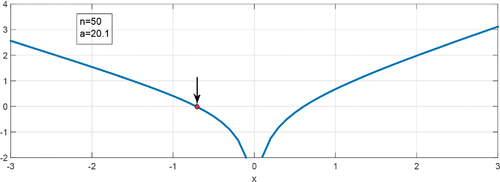
Two examples of the computation of the zeros of obtained using our algorithm, are shown in Figure 4. The zeros of evaluated for two values of a () are plotted in the figure. In Table 9 we give explicit values of some of the zeros found for .
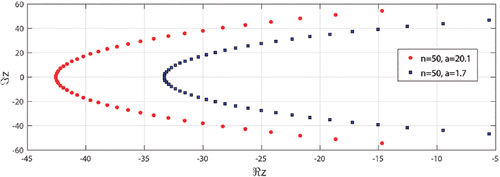
Two example of computation of the zeros for Bessel polynomials () are shown in Figures 5 and 6. The values of n have been fixed to 20 and 100, respectively. We also show contour plots of the modulus and phase of and , where the position of the zeros is clearly shown in the figures. These plots are generated using Matlab and the relation to the modified Bessel function given in Equation (8). Also for the case of Bessel polynomials, explicit values of the zeros found with our algorithm are given in Table 10 for . The calculations have been made in double precision accuracy. The function values at the zeros are also shown in the table.
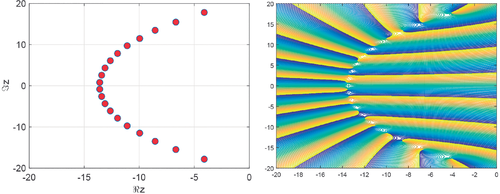
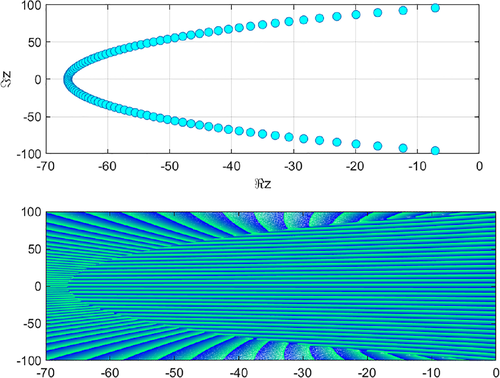
4 CONCLUSIONS
The problems of computing the reverse generalized Bessel polynomials and their zeros have been considered in this article. For computing the polynomials, the numerical performance of asymptotic expansions in terms of elementary functions given in Reference 5 has been illustrated with examples. We have shown that with very few coefficients in the expansions, an accuracy better or close to single precision can be obtained even for moderate values of n. We have also analyzed the conditioning of the linear homogeneous three-term recurrence relation satisfied by the polynomials. We have concluded that the polynomials are an asymptotically dominant solution of the recurrence relation. Therefore the forward computation of the recursion is well conditioned for large enough values of n. However, special care has to be taken when using the recurrence in the region where the zeros of lie. With respect to the zeros of the polynomials, the computational performance of an efficient and accurate algorithm to evaluate the zeros has been shown in different examples. The method8 behind the algorithm is based on a qualitative analysis of the approximate Liouville-Green Stokes lines and anti-Stokes lines of the differential equation satisfied by the polynomials, combined with the application of a high-order fixed-point method and carefully selected step functions. The algorithm is shown to be efficient and accurate for all the parameters tested.
ACKNOWLEDGMENT
The authors acknowledge financial support from Ministerio de Ciencia e Innovación, Spain, project PGC2018-098279-B-I00 (MCIU/AEI/FEDER, UE).
Biographies

T. Mark Dunster received the B.Sc. degree from Reading University, UK, and his Ph.D. degree from Bristol University, UK. Currently, he is Full Professor in the Department of Mathematics and Statistics, San Diego State University, USA. His research interests include asymptotics, special functions, ordinary differential equations, and scattering theory.

Amparo Gil received both the B.Sc. and her Ph.D. degrees from University of Valencia, Spain. Currently, she is a full professor of Applied Mathematics in the Department of Applied Mathematics and Computer Sciences, University of Cantabria, Spain. She is an associate editor of the Digital Library of Mathematical Functions project. Her research interests are numerical analysis and computational methods for special functions.

Diego Ruiz-Antolín received both the B.Sc. degree and his Ph.D. degree from University of Cantabria, Spain. His research interests are numerical analysis and computational methods for special functions. He is an assistant professor in the Department of Applied Mathematics and Computer Sciences, University of Cantabria, Spain.

Javier Segura is a full professor of mathematical analysis at University of Cantabria, Spain. His main fields of interest are special functions and numerical analysis. He is a coauthor (with A. Gil and N. M. Temme) of the book "Numerical Methods for Special Functions" published by SIAM in 2007. Segura is a member of the IFIP Working Group 2.5 on Numerical Software and he is an associate editor of the Digital Library of Mathematical Functions project.



